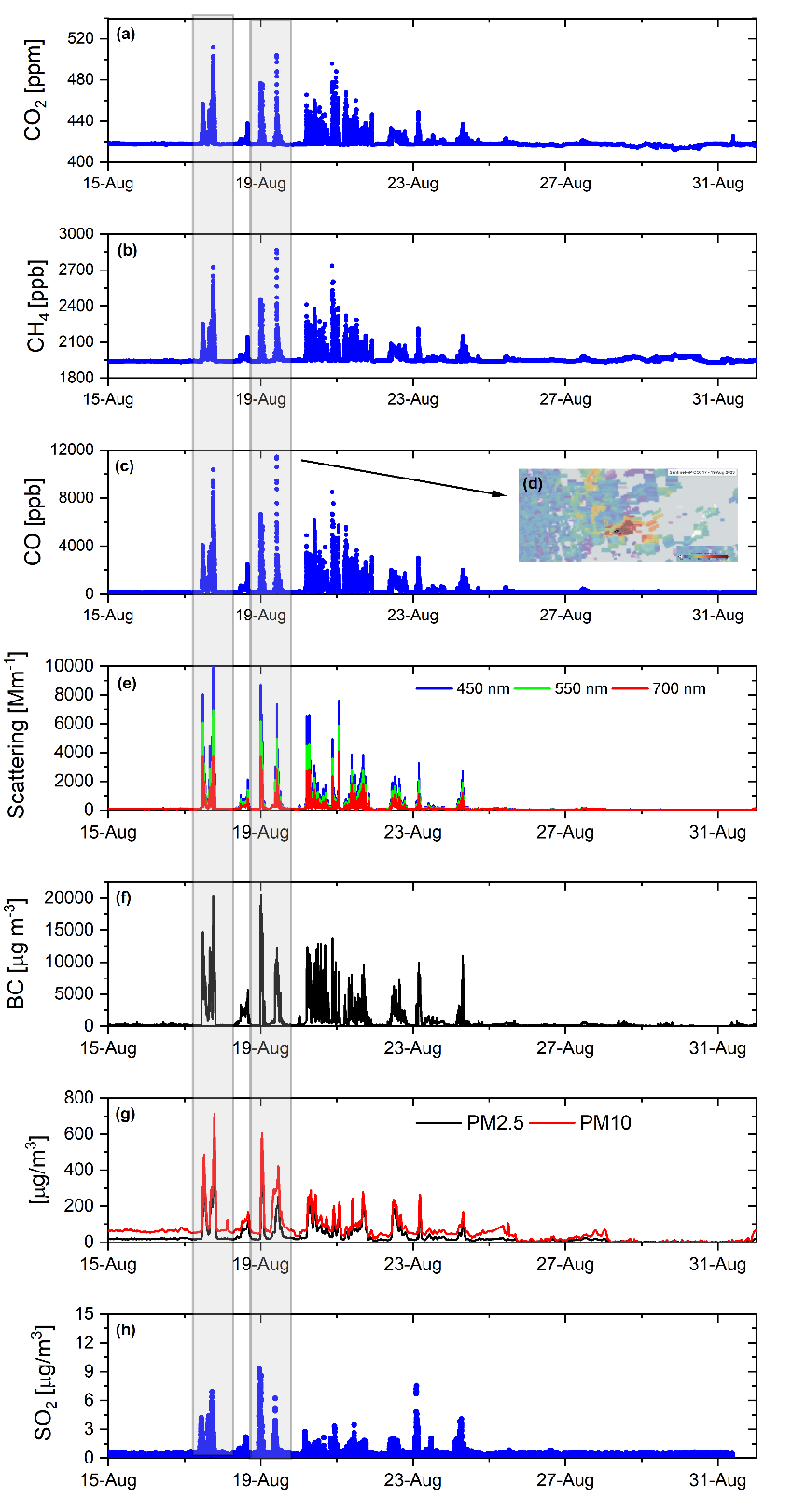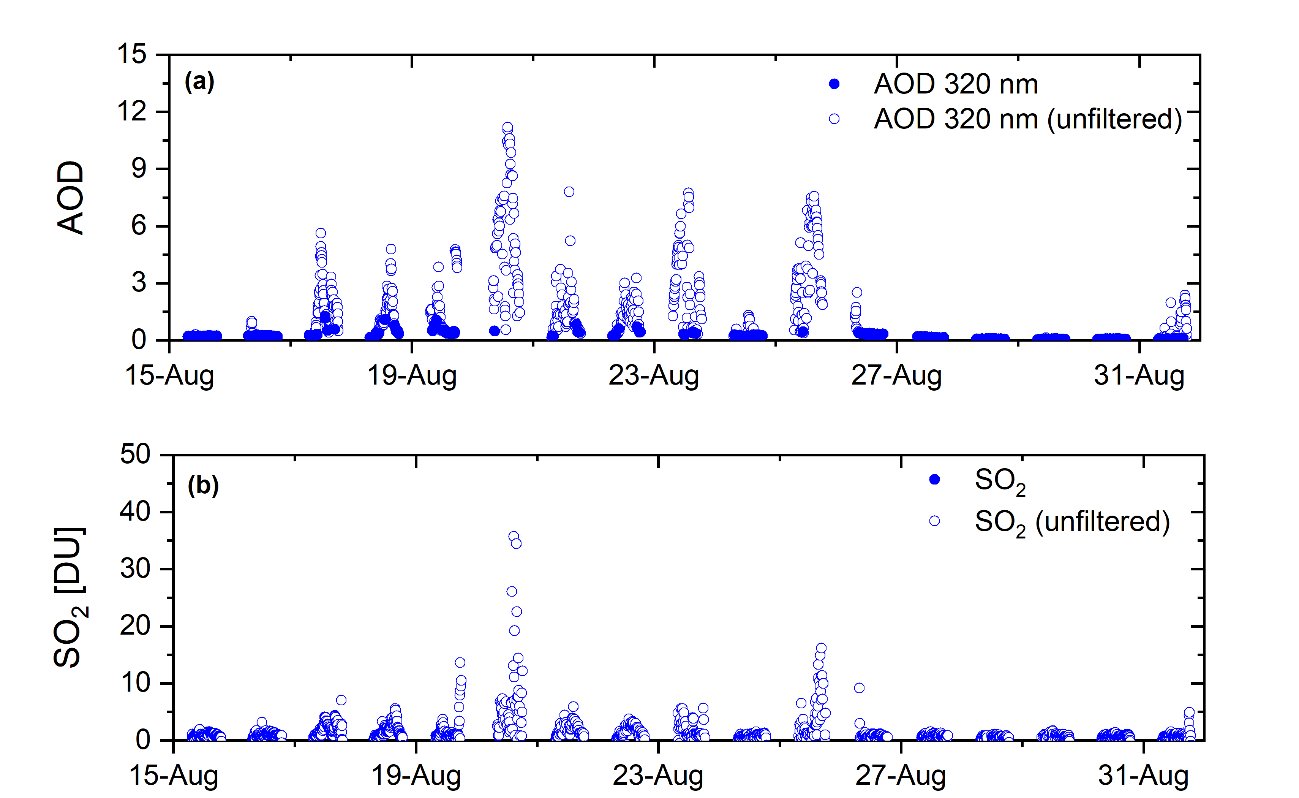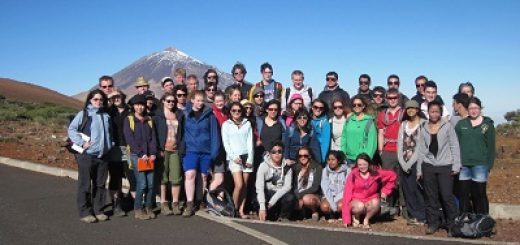Impact of the august wildfire in Tenerife on the CIAI-AEMET measurement program
Clic here for spanish version
On August 15th, one of the most devastating wildfires in recent memory began in the highlands of the municipality of Arafo on the island of Tenerife. Despite immediate efforts to control it, the fire rapidly spread both northward into the La Orotava Valley and southward into the Güimar Valley, affecting 12 municipalities and over 12000 hectares of land. On August 20th, the fire even reached the Izaña Mountain, home to the Izaña Observatory (IZO) managed by the State Meteorological Agency (AEMET) through the Izaña Atmospheric Research Center (CIAI) (Figure 1). Thanks to the swift action of firefighting resources, the observatory’s infrastructure was spared, and the fire was ultimately brought under control in the following days.
Despite the severity of the fire in the observatory’s vicinity, most of the CIAI’s measurement programs remained operational. However, the fire’s impact was evident in anomalies recorded in routine measurements of the World Meteorological Organization’s (WMO) Global Atmosphere Watch (GAW) programs, including greenhouse gases and in-situ aerosols, which also serves as an ACTRIS (Aerosol, Clouds and Trace Gases Research Infrastructure) observation platform. The impact was also observed in other programs, such as column aerosols, radiation, reactive gases and various atmospheric parameters measured at the station.
 Figure 1 – (a) Image captured by the MODIS (Moderate Resolution Imaging Spectroradiometer) sensor aboard NASA’s Terra satellite on August 18, 2023 (Image: NASA Worldview; https://worldview.earthdata.nasa.gov/). The red dot marks the location of the Izaña Observatory. (b) Image captured by IZO cameras on August 20th at the observatory entrance. (c) Image of Teide National Park taken from IZO on August 19th (Teide Cloud Laboratory Project, #TeideLab).
Figure 1 – (a) Image captured by the MODIS (Moderate Resolution Imaging Spectroradiometer) sensor aboard NASA’s Terra satellite on August 18, 2023 (Image: NASA Worldview; https://worldview.earthdata.nasa.gov/). The red dot marks the location of the Izaña Observatory. (b) Image captured by IZO cameras on August 20th at the observatory entrance. (c) Image of Teide National Park taken from IZO on August 19th (Teide Cloud Laboratory Project, #TeideLab).
In the context of the Greenhouse Gas Monitoring Program (GAW), the maximum recorded CO2 value exceeded 500 ppm on August 17th (normal values measured at IZO range between 410 and 430 ppm) (Figure 2a). Additionally, on August 19th, the maximum recorded values of CH4 and CO were greater than 2800 and likely over 10.000 ppb, respectively (Figure 2b, c) (normal values for CH4 range between 1800 and 100 ppb, while CO values range between 50 and 200 ppb at the Izaña station).

Figure 2 – Time series of surface concentrations of: (a) CO2 (ppm), (b) CH4 (ppb), (c) CO (ppb), (d) CO map taken by the TROPOMI satellite between August 17th and August 18th, 2023, (e) scattering coefficient measured with the nephelometer in Mm-1, (f) black carbon content in µ·gm-3 measured with the MAAP, (g) concentration of particulate matter with an aerodynamic diameter equal to or less than 2.5 microns (PM2.5) and 10 microns (PM10), respectively, in µg·m-3 measured with the TEOM and (h) SO2 (µg·m-3) measured at the Izaña Observatory between August 15th and August 31st, 2023.
Measurements taken during the wildfire by in-situ aerosol property measuring instruments reached maximum values far from the typical values usually recorded at IZO, as shown in Figures 2 and 3. During the wildfire, the values of the scattering coefficient (Figure 2e) and the values of black carbon content (Figure 2f) reached the highest levels recorded at the Izaña Observatory since records have been kept since 2012.
Figure 3 illustrates the temporal evolution of aerosol optical thickness (AOD) at 500 nm and the Ångström Exponent (AE) parameter measured at IZO. The maximum values of AOD at 500 nm (AE) were 3.63 (2.14) and 4.16 (1.71) recorded on August 17th and August 20th, 2023. These values represent the highest AOD values ever recorded at the Izaña station since it joined the Aerosol Robotic Network (AERONET) in 2005.

Figure 3 – Time series of aerosol optical thickness at 500 nm (left axis; blue) and Ångström parameter (right axis; gray) measured at the Izaña Observatory between August 15th and August 31st, 2023. The data belong to the AERONET network (https://aeronet.gsfc.nasa.gov/), Level 1.5, Version 3.
The temporal evolution of AOD at 320 nm and the total column of SO2 determined from measurements with the Brewer spectrophotometer #183 at IZO are shown in Figure 4. This instrument belongs to the Regional Brewer Calibration Center for Europe (RBCC-E, http://rbcce.aemet.es/). The figure also includes data flagged for quality control and requiring further evaluation.

Figure 4 – Time series of (a) aerosol optical thickness at 320 nm and (b) SO2 (DU) obtained from measurements with the Brewer spectroradiometer at the Izaña Observatory between August 15th and August 31st, 2023.
Within the framework of the WMO Commission for Instruments and Methods of Observation (CIMO-Testbed) activities, spectral global, direct, and diffuse radiation measurements made with the EKO-RSB spectroradiometer at IZO were significantly affected during the wildfire. Figure 5 shows the differences between measurements under clean atmospheric conditions (August 6th; Figure 5a) and those affected by the wildfire on August 17th at 13:00 UTC (Figure 5b).

Figure 5 – Spectral radiation (global, direct, and diffuse) measured between 300 and 1100 nm with the EKO-RSB spectroradiometer at the Izaña Observatory on (a) August 6, 2023, at 13:00 UTC under clean conditions, and (b) August 17, 2023, at 13:00 UTC under conditions affected by the wildfire. The small images were taken by the SONA camera (Automatic Cloud Observation System).
Following maintenance and cleaning of all observatory instrumentation, normal operations were restored at the end of August. Furthermore, all the measurements taken during this period will be of great importance to determine in future studies how a fire as important as the one that occurred on the island of Tenerife affects the composition of the atmosphere.
On the other hand, from CIAI-AEMET we want to give, once again, our most sincere thanks to all the management and extinction services that participated in the control and extinguishment of the fire, and that allowed us to keep safe all the infrastructures that they are part of this centenary Observatory and the highly sensitive scientific instrumentation that is installed in it.






